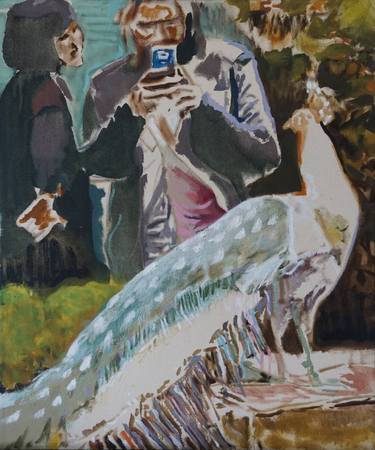The Impact of Figurative Oil Painting on Modern Art and Society
The Impact of Figurative Oil Painting on Modern Art and Society
Blog Article
A Journey Through the Globe of Metaphorical Oil Paint: Discovering the Distinct Qualities and Psychological Deepness of the Medium

Background of Metaphorical Oil Paint
Emerging during the late Center Ages and thriving throughout the Renaissance, figurative oil paint has an abundant background that reflects both creative technology and cultural evolution. At first, oil paints were used in Europe as a way to boost the luminance and deepness of color in artworks. Musicians such as Jan van Eyck originated the medium, showing its potential to capture elaborate information and textures, thus permitting for a much more natural depiction of the human kind.
As the Renaissance progressed, prominent figures like Leonardo da Vinci and Michelangelo broadened the boundaries of figurative oil paint. They highlighted physiological accuracy and perspective, producing jobs that communicated emotion and narrative deepness. The tool's adaptability allowed for experimentation with light and shadow, causing the advancement of chiaroscuro strategies that even more improved the aesthetic experience.
Distinct Features of the Medium
The evolution of figurative oil painting has been dramatically affected by the unique qualities of the medium itself. Oil paint, composed of pigments put on hold in oil, uses artists an exceptional adaptability that permits a vast array of finishes and structures. Its slow-moving drying time makes it possible for precise blending and layering, which can develop depth and luminosity unattainable in other tools.
Additionally, oil paint's abundant pigmentation gives dynamic shades that preserve their intensity in time. This particular is crucial in metaphorical paint, where catching the subtleties of skin tones and emotional expressions is critical. The capacity to achieve soft changes and subtle gradients enhances the realistic top quality of topics, enabling musicians to communicate complicated emotions.
Additionally, oil paint adheres well to numerous surfaces, such as steel, canvas, and wood, widening the extent of creative expression. The tool's adaptability supports different approaches, from comprehensive realism to meaningful brushwork, allowing musicians to explore their individual designs.
Ultimately, the distinct homes of oil paint not just enrich the aesthetic experience but likewise equip musicians to connect profound stories, making metaphorical oil painting a deeply expressive art type.
Designs and techniques Employed
Within the world of metaphorical oil painting, musicians use a diverse variety of techniques and styles that add to the deepness and richness of their job. One famous technique is glazing, where clear layers of paint are applied over dried layers, allowing light to penetrate and mirror, improving brightness and depth. This method is frequently utilized to accomplish a feeling of realistic look and complexity in complexion.
Another method is impasto, where thick layers of paint are used with a scheme knife or brush, developing a textured surface that adds a three-dimensional top quality to the painting. This style can evoke a Click Here natural reaction, attracting my sources the customer in via its tactile nature.
Artists also discover numerous brushwork designs, from penalty, in-depth strokes that catch complex functions to more comprehensive, more expressive strokes that share movement and emotion (figurative oil painting). The selection of shade combination significantly influences the overall mood of an item, with cozy tones frequently giving sensations of comfort and great tones recommending sorrowful
Moreover, the integration of chiaroscuro, the contrast between light and darkness, enables musicians to develop remarkable effects that enhance the narrative top quality of their work. Each strategy and design is meticulously chosen to raise the audience's experience and understanding.
Emotional Deepness in Metaphorical Art
Emotional depth offers as a keystone in figurative art, permitting musicians to transcend simple representation and engage customers on a profound level. This psychological resonance is often achieved with the nuanced representation of human numbers, expressions, and communications. Artists harness the power of color, darkness, and light to evoke feelings that reverberate deeply with the target market, developing a visceral link to the topic.
In metaphorical oil painting, the detailed layering of paint can reflect the complexities of human feeling. The selection of palette, whether amazing or warm, plays a crucial role in setting the state of mind and atmosphere of a piece. Softer their explanation shades might stimulate serenity and self-questioning, while bold, different colors can connect tension and drama.

Influential Artists and Their Works
Numerous significant musicians have dramatically formed the landscape of figurative oil painting, each contributing special viewpoints and strategies that remain to inspire modern designers. Among these artists, Lucian Freud attracts attention for his extreme mental depth and raw portrayal of the human form, commonly blurring the lines between beauty and degeneration. Freud's jobs, defined by thick, impasto brushstrokes, invite audiences to confront the intricacies of identification and susceptability.

Similarly, Andrew Wyeth's thorough realistic look in pieces like "Christina's Globe" records profound narratives within seemingly straightforward compositions. His use light and shadow stimulates a sense of nostalgia and emotional resonance, attracting audiences into the intimate worlds he represents.
In the realm of contemporary art, Kehinde Wiley has gotten acknowledgment for his lively, larger-than-life portraits that challenge standard ideas of representation. By putting people of shade in contexts evocative classical portrait, Wiley's work redefines the canon of art history.
These artists, along with others, have not only enriched metaphorical oil painting but have actually additionally expanded the discussion bordering society, identification, and emotion, guaranteeing that the medium continues to be a crucial kind of expression in the art globe. figurative oil painting.
Conclusion
In final thought, figurative oil painting continues to be a powerful medium that envelops the intricacies of human emotion through its rich pigmentation and functional methods. The historic evolution of this art form, incorporated with its one-of-a-kind characteristics, permits profound creative expression. Techniques such as glazing and impasto boost the emotional resonance of each piece, while the contributions of prominent artists proceed to motivate and form the discourse bordering this timeless style. The trip via metaphorical oil paint exposes its lasting significance in the art world.
The expedition of figurative oil painting provides an extensive understanding into the interaction of method, feeling, and historic context that defines this age-old medium. Oil paint, made up of pigments suspended in oil, uses artists an exceptional versatility that permits for a broad variety of appearances and coatings.Within the world of metaphorical oil painting, musicians use a diverse array of methods and styles that contribute to the depth and richness of their work.Many significant musicians have significantly shaped the landscape of figurative oil painting, each adding distinct point of views and techniques that proceed to inspire modern creators.In conclusion, figurative oil painting stays a powerful tool that envelops the complexities of human emotion via its abundant pigmentation and functional strategies.
Report this page